Top Workday Training Institutes in Bengaluru near me
Workday Studio Training in Bengaluru
Error Handling through Workday Studio
Working with Workday Studio requires managing errors efficiently; recently an async component was added to manage error logging for mandatory fields, followed by another component and swim lanes containing send error steps; these were eventually forwarded onto another async component dedicated cloud logging.
Workday Studio Training in Bengaluru can help understand and implement such async components effectively.
Errors take priority; when an error variable does not equal zero, Workday Studio flags it as such to allow swift corrective action to take place quickly and ensure effective outcomes.
Once an integration runs successfully, Workday Studio generates a log file with all of its details, providing important insights.
Should any issues arise that need attention, Workday Studio logs these specifically allowing you to more efficiently pinpoint their sources – providing essential clarity when maintaining seamless workflows.
Workday Studio Configuring Validations
Setting up validations in Workday Studio is of critical importance in order to maintain data integrity.
As one configuration adjustment example, replacing employee ID fields with cost center fields, with warning messages issued if left blank is paramount in keeping information flowing freely within Workday.
These validations must therefore remain intact to keep your records in line and secure.
With Workday Studio Training in Bengaluru, mastering such validations becomes more streamlined.
Workday Studio Logging Made Simple
Logging was made straightforward through consistent variable usage.
Reusing a similar log structure, we just tweaked message types as necessary between errors and warnings.
To create a robust log system with uniform variable names and tailored messages for errors/warnings/warns etc.
This practice is thoroughly covered during Workday Studio Training in Bengaluru.
Deploying and Testing in Workday Studio
Deployment and testing are an integral component of Workday Studio use.
Once saving and deploying configuration data, tests were run to make sure everything functioned as intended the first test revealed syntax errors within one expression that needed resolving.
Once resolved, redeployment took place successfully before tests ran again all without issue this time.
Workday Studio requires an innovative strategy for managing success logs. Successful records were indicated via tailor-made messages like, ‘Record processed successfully for Employee ID X and Name Y.’
The logs distinguished successful transactions using message type ‘info” so users could clearly differentiate errors, warnings and successes.
Mastering deployment through Workday Studio Training in Bengaluru can make this process more effective.
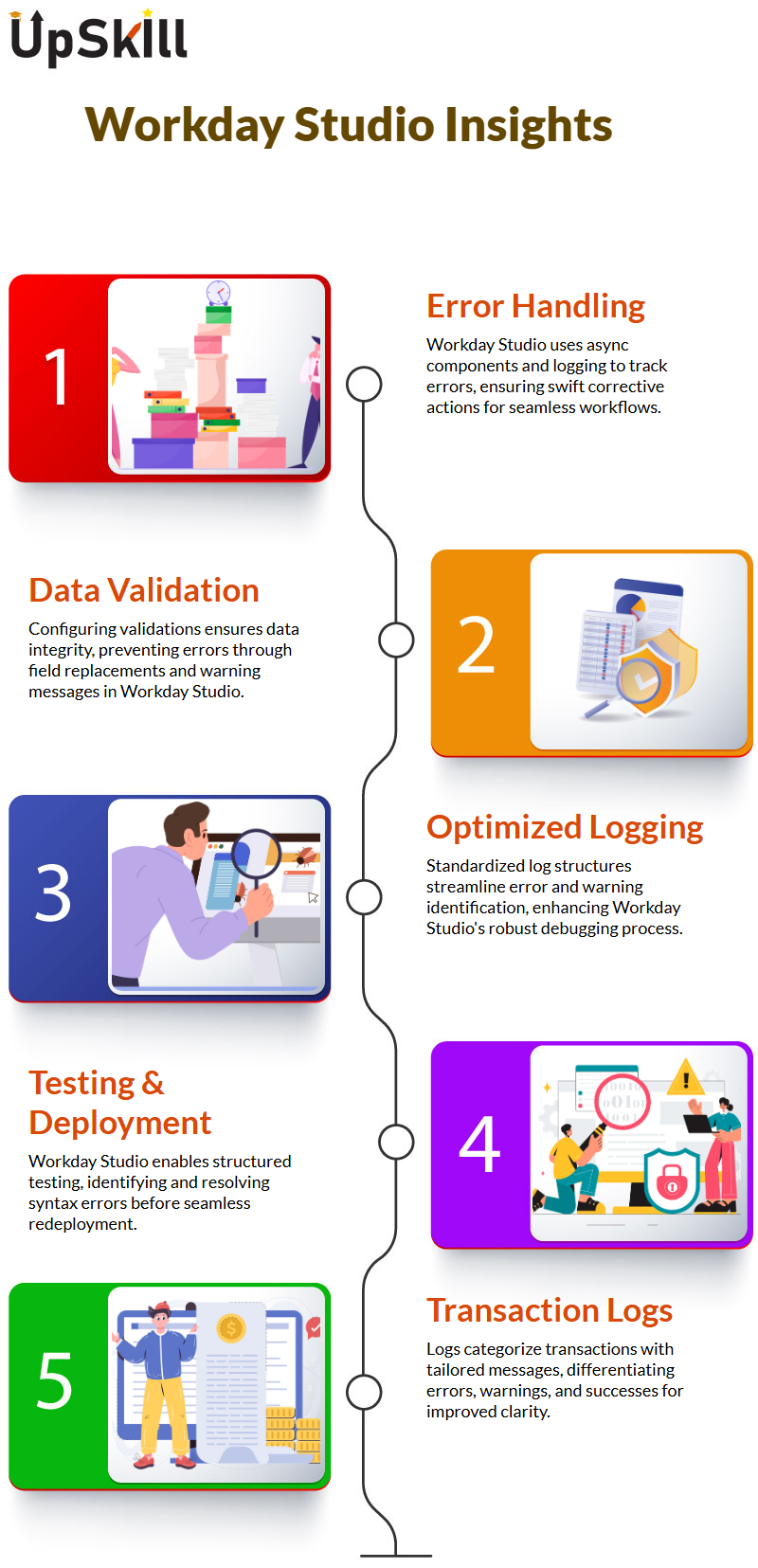
Workday Studio Conditions
Let’s dive deep into Workday Studio and its components in terms of handling conditions efficiently, while managing cloud logs effectively to maintain consistency within variable names.
Setting and populating variables are easy; simply adjust their data content – for instance, altering an error level or information level as appropriate will suffice.
Workday Studio components all contain execute steps linked to various conditions.
Consider, for instance, a component with an execution step with an associated condition marked in brown at its top.
Training like Workday Studio Training in Bengaluru offers deep dives into such components.
When this condition becomes true, its execution occurs; for instance, if either cost center or location fields are blank when they should not be, an async step processes this data and keeps workflow running without errors.
Step-by-Step Debugging in Workday Studio
Once deployed and running your integration, it becomes evident almost instantaneously that changes have taken place.
Consider shifting warnings from “send error” to the main component instead.
When reviewing output files, you could notice several info messages and warnings which differ significantly; customizing these warning messages for better clarity could help identify problems quickly and proactively.
Programmers looking for ways to track errors, warnings and successes using Workday Studio should declare variables for errors, warnings and successes at the outset and set them at zero initially; as errors, warnings or successful events arise they’ll increment accordingly.
For instance, when an error happens increase it by one and similar incrementing should take place with warnings or successes as events come through; by the time processing concludes you should have an accurate count for all three; helping monitor integration performance more closely.
Let’s move onto managing integration statuses in Workday Studio, now.
Perhaps you have experienced situations in which an integration marked as completed still has errors in its output file; this can be misleading because it indicates no further action are required.
To address this, the “put integration message” feature allows users to categorize warnings or errors so nothing gets overlooked by unknowing users.
Workday Studio Training in Bengaluru helps you explore integration management in greater depth.
Understanding Workday Studio Integration Logic
One key part of Workday Studio is setting up integration flows. Imagine having three statuses info, warning and error.
Your goal should be to execute only one status at a time for maximum clarity and precision in logs; don’t try doing everything at once; rather focus on doing only what matters at each given point in time.
Workday Studio allows users to set conditions for execution using variables to trigger each status.
When an integration completes successfully it will show as info status in Workday Cloud and show as completed successfully with no errors and warnings displayed as its status.
If all error and warning variables equal zero then its integration status will indicate “completed successfully”, showing as completed successfully in its status column.
The logic behind this is elaborately explained in Workday Studio Training in Bengaluru.
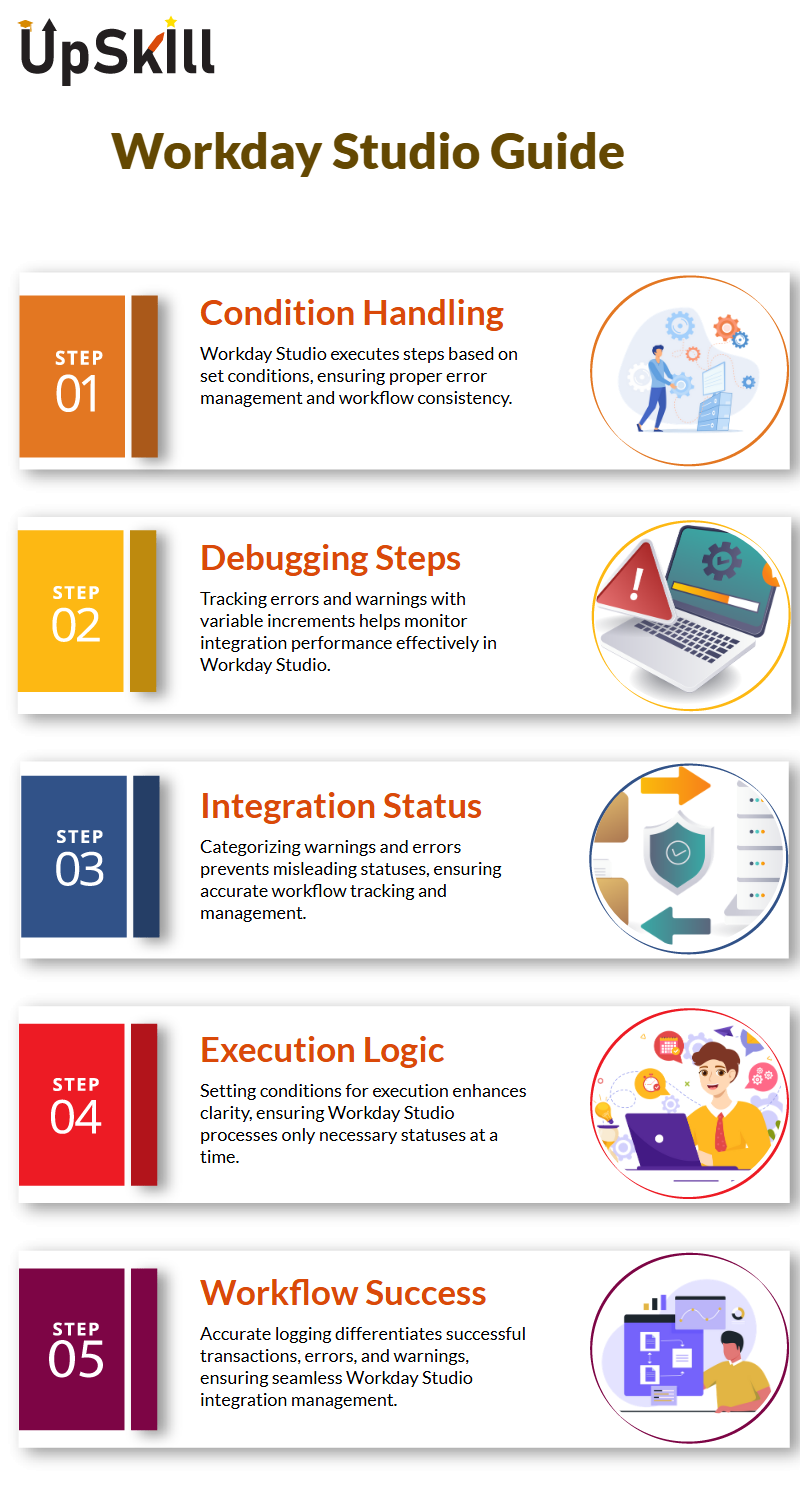
Warnings in Workday Studio
Warnings play an essential part in Workday Studio, signalling when warning variables exceed zero while error variables do not.
This ensures your integration accurately conveys its status. Workday Studio allows for greater usability by enabling custom messages.
For example, variables directly can be printed into warning messages to provide actionable insights on next steps; all part of being proactive rather than reactive! These aspects are discussed extensively in Workday Studio Training in Bengaluru.
Logging and Integration Messages in Workday Studio
Log files provide an indispensable means of understanding what happened during an integration.
Workday Studio ensures that every event errors to warnings are recorded here so you can easily assess its status.
If your log shows two warnings and two errors, Workday Studio’s detailed logs not only offer transparency but can assist in taking corrective actions as needed.
Payroll Integrations with Workday Studio
Let’s dive deeper into Workday Studio, an integrated data solution.
Imagine receiving an employee file for payroll processing as an input source file and working through that in Workday Studio.
Workday Studio allows us to augment the data by retrieving extra details about hire date and company details for instance by calling reports and web services in order to populate extra columns into our file.
Imagine an input file contains basic employee fields like their name, date of birth, employee ID number, cost center name and location information.
It allows us to expand this file with additional data, making it a critical asset in ensuring the accuracy and completeness of payroll inputs. Workday Studio Training in Bengaluru provides hands-on practice with such use cases.
Manages integration IDs seamlessly. Every object in Workday, such as companies and cost centers, have individual Workday IDs which vary based on which tenant implementation tenant it belongs to.
It is also worth noting that these tenant-specific IDs could change over time as tenants make changes within Workday implementation projects.
When working with web services, you have two methods available to you for passing values: Organisation Reference ID or Company Reference ID.
Workday Studio Training in Bengaluru discusses ID management best practices in depth.
In terms of cost centers, Workday Studio provides organization reference IDs and cost center reference IDs which may or may not match up with actual names showing its flexibility.
It makes data configuration and processing efficient, whether that means payroll input files or complex business objects.
One standout feature of Workday Studio is its capacity for handling unique identifiers across data types.
Locations can be managed using IDs which differ or match their names; similarly, cost centers use reference identifiers like organization reference ID and cost center reference ID to ensure data integration.
Excels at processing web service inputs. By permitting reference IDs such as for companies or cost centers, Workday Studio makes the passing of values through integrations easier than ever.
It makes an invaluable tool for tasks such as supplementing payroll input files with additional employee details. Many learn these skills through Workday Studio Training in Bengaluru.
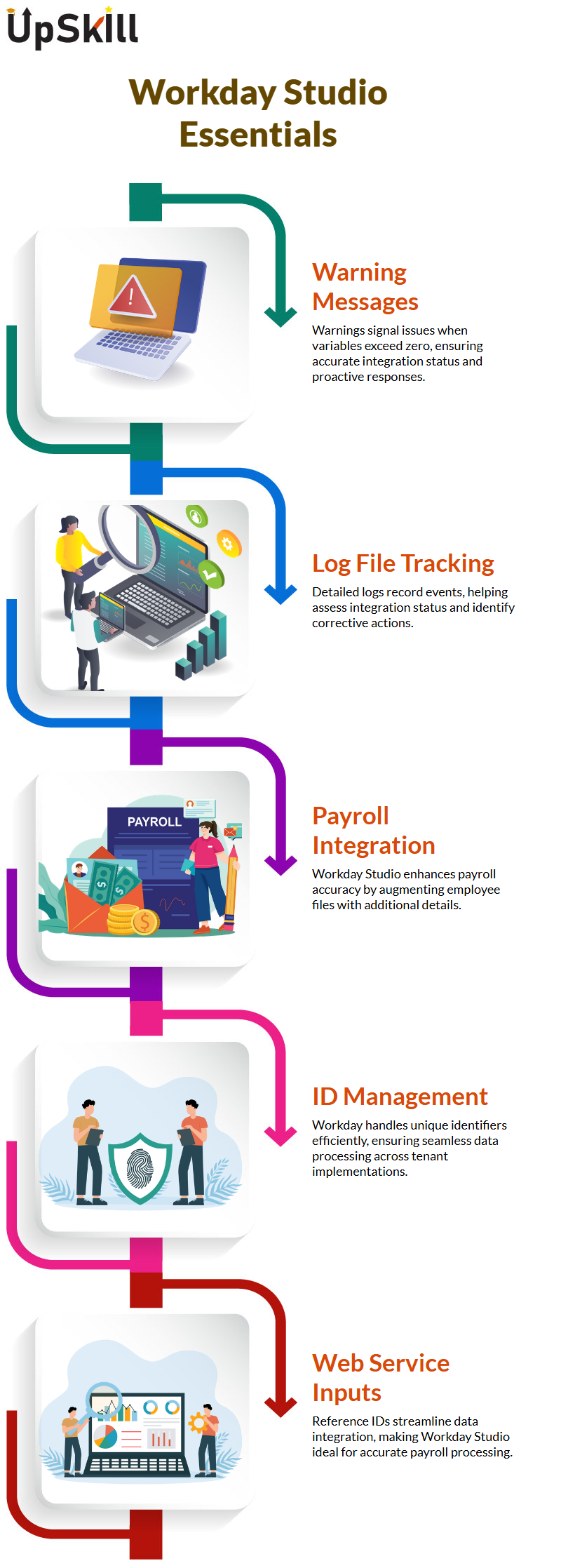
Advanced Features involved Workday Studio
Workday Studio allows you to seamlessly meld data from different sources into a comprehensive dataset while maintaining its consistency.
Its advanced features make it an invaluable tool for managing and configuring business objects – thus, making Workday Studio essential in maintaining comprehensive datasets.
Workday Studio excels at adapting to various scenarios ranging from payroll processing and data configuration, through efficient web services integration management.
Utilising integration IDs efficiently ensures accurate and comprehensive integration.
Mastering Hash Maps for Efficient Data Loading
Have you ever found yourself trying to upload large volumes of data into Workday Studio and became overwhelmed by its complexity?
Let’s consider an effective and practical method for handling situations where reference IDs must quickly populate web services efficiently.
When working with Workday Studio, understanding and using hash maps will make this process much smoother.
Imagine working with a file listing cost center names such as Finance or HR along with their respective locations such as Atlanta.
While you might recognize these names, what you really require in Workday Studio to add these entities are their respective reference IDs.
These IDs don’t correspond directly with names; for instance, Finance may appear as “CC123”, while HR would need an HR001 ID number before moving ahead with anything further.
Finding those IDs should never be overlooked before moving ahead in any project or endeavour.
This relies on these reference IDs as its foundation, with creating reports mapping cost center names to their IDs being the key to unlocking them.
Workday Studio’s hash maps allow users to store data as key-value pairs, making retrieving reports or data files significantly simpler.
Once loaded into memory, cost center names become keys while their reference IDs become values in an accessible hash map for instantaneous retrieval without multiple queries being performed on it.
This step ensures that when passing key based queries, you instantly obtain their respective values without constantly querying reports for additional answers.
It makes integration effortless; seamlessly connecting hash map operations into your workflows can save both time and energy, helping save both valuable time and effort. These advanced uses are taught during Workday Studio Training in Bengaluru.
Hash Map Management in Workday Studio
Workday Studio makes hash map creation straightforward: simply declare, populate, and call.
No matter whether you are dealing with XML files, JSON conversions or splitters; Workday Studio ensures efficient data processing at every turn.
Getting Started with Workday Studio Data Processing
Workday Studio begins by employing a splitter to process individual XML rows separately, each row containing cost center information or attributes like cost center attributes.
In order to access relevant values quickly and efficiently, it’s necessary to set up key and syntax values accordingly.
These uses XPath expressions to extract data from XML documents, with cost center reference syntax following a specific structure.
Hash Maps can also be used as another data gathering technique within Workday Studio.
Working within Workday Studio requires managing hash maps effectively for organizing and retrieving data efficiently.
When extracting cost centre details, we would store them into variables called props or props name to facilitate further processing of our cost centers.
Once we’ve defined all necessary properties, the next step should be calling our hash map using its keys.
In Workday Studio this requires declaring, populating and calling upon any stored values; using put method we then store those variables temporarily before calling them later as reference variables.
Workday Studio Training in Bengaluru supports mastering such structured logic for real-world data handling.
Let this makes use of it get method to dynamically retrieve values dynamically and integrates this approach with workflows for structured data retrieval and seamless integration.
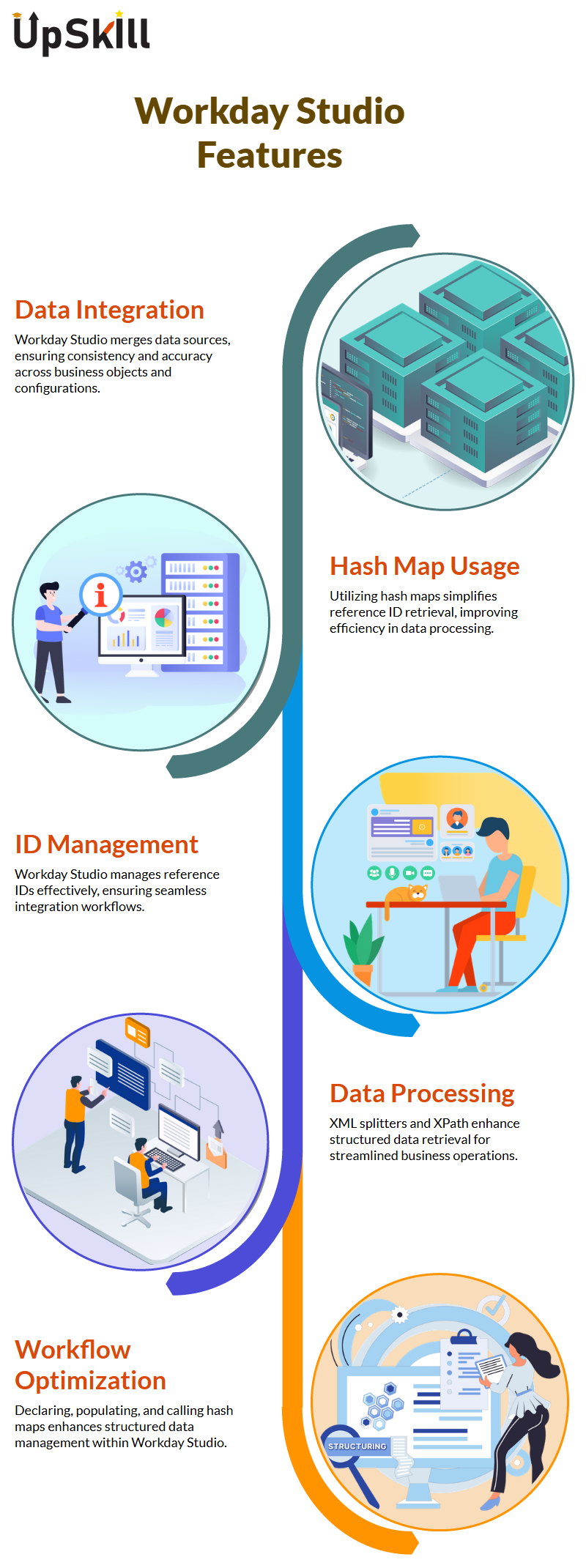
Optimizing Workday Studio XML Parsing
Parsing XML efficiently within Workday Studio requires careful consideration to variable assignments and processing steps, including verifying reference IDs before calling web services.
Workday Studio empowers users to extract values seamlessly within predefined workflows, providing smooth operations while upholding accuracy in data extraction and processing logic.
Users can gain more automation while keeping accurate records.
Workday Studio makes managing complex data sets easily without manual intervention through structured mapping, while dynamic variables ensure seamless handling of reports for optimal efficiency.
HashMap in Workday Studio
Workday Studio is an extremely useful tool that ensures seamless integrations within the Workday ecosystem, yet requires precise entity testing in order to work optimally.
When conducting entity tests with Workday Studio it is critical that entity tests are accurate; recently a demo was performed in order to understand its workings more thoroughly such as how it handles different input data by declaring all variables correctly before setting integration points.
As this step can have devastating ramifications when used with HashMap in Workday Studio.
All these features have core functionalities in the form of HashMap’s to store information.
Before using one, we must check to make sure it contains correct data.
Workday Studio Training in Bengaluru offers deep insights into such test scenarios and setup validations.
Let’s makes populating HashMap easier by fetching structured data via Workday Out Rest and connecting it with an XML stream splitter, followed by error logging capabilities in Workday Studio.
Test Workday Studio Integrations
One way of testing Workday Studio integrations effectively is through progressive deployment of configurations.
Testing reports and reviewing logs also assists in troubleshooting.
Workday Studio provides tools to efficiently analyze errors. A blank report signifies something needs to be adjusted;
Refining Workday Studio Workflows
Workday Studio supports various integration scenarios, from data parsing to complex workflows.
Split XML files enhance processing efficiency. Workday Studio’s flexibility makes it ideal for meeting changing enterprise data needs.
Workday Studio Logs and Processes
Here’s an introduction to exploring Workday Studio logs and processes so you can gain a full picture of everything happening behind-the-scenes.
Imagine being immersed in the server log where all the action happens; but sometimes unexpected errors arise that require long hours spent working through Workday Studio to remedy.
These challenges are shared among many users who work within Workday.
Let’s consider report data and entry as key elements found within Workday Studio.
As with anything new, connecting all the pieces and making deployment go as smoothly as possible are always priority one.
Sometimes this requires sorting through logs repeatedly to identify issues before working towards making small, incremental fixes until eventually everything falls into place.
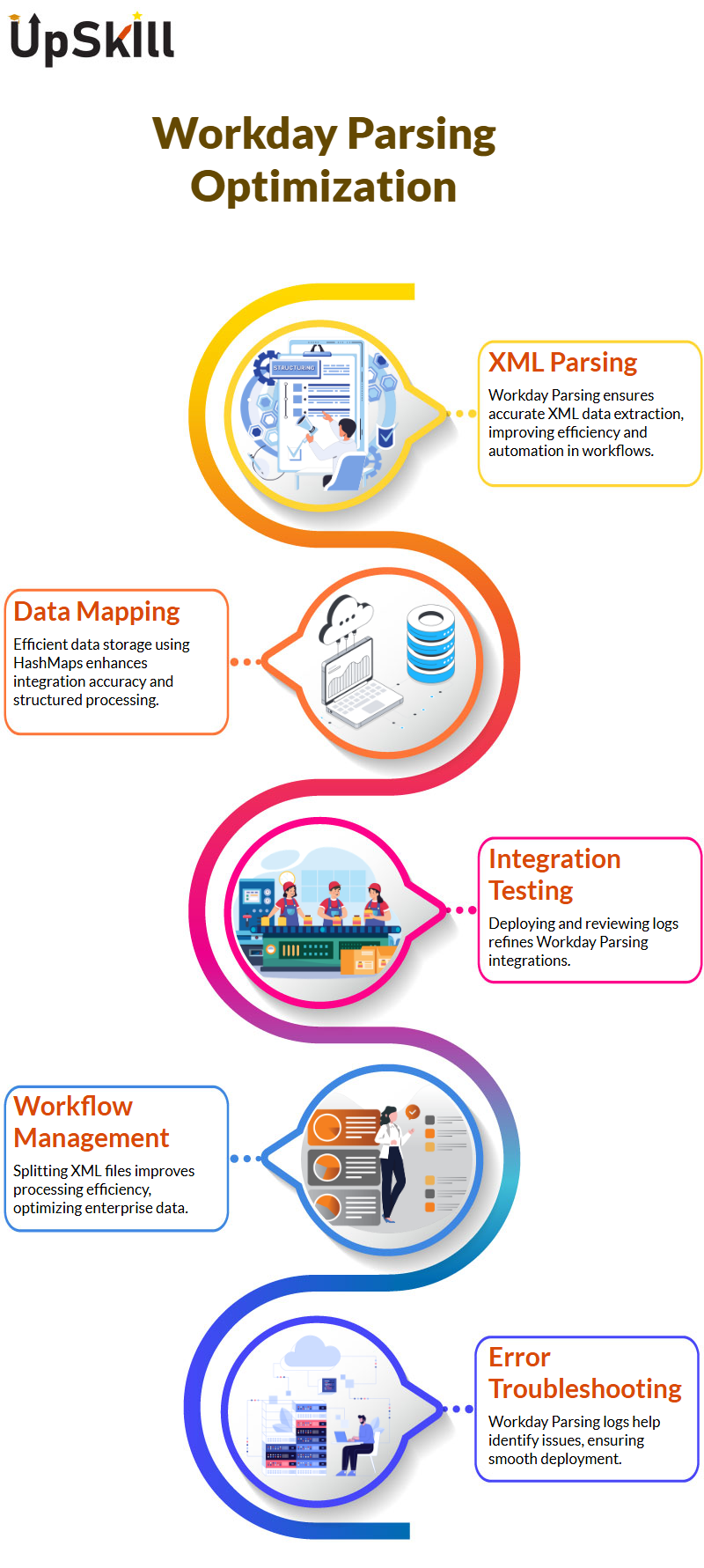
Making Sense of Workday Studio Namespace
Now let’s dive into Workday Studio’s namespace aspect, which can sometimes prove challenging when dealing with fragments or hashes.
When naming variables for instance, keeping their naming convention consistent and populating them systematically are both essential steps towards making sure everything runs as expected.
Props and parts play an integral part in Workday Studio, serving as the building blocks you’ll use to organize processes.
Hashing maps offer additional organization – populating keys takes careful thought; my experience shows this method keeps everything streamlined while remaining easy to debug.
One of the most rewarding parts of using Workday Studio is witnessing how data transforms smoothly into its respective places.
Imagine entering employee details, cost centers and locations into your input file: your first task should be splitting this information systematically into separate fields.
Through these efforts, data can be stored in an easily navigable hash map format making the transformation incredibly exciting to witness as rows of data come in for processing.
Next, these data points are connected to the hash map using Workday Studio’s seamless mapping process; when passing in cost center name into hash map for retrieval of ID (cost center ID is always returned by hash map), etc.
Logs will also be generated at this step to ensure everything works as anticipated.
This process, as taught in Workday Studio Training in Bengaluru, ensures practical comprehension of mapping and parsing techniques.
Professionals attending Workday Studio Training in Bengaluru consistently report improved project confidence and fewer errors during deployment.
Hands-on projects form a core part of Workday Studio Training in Bengaluru, helping reinforce best practices through direct application.

